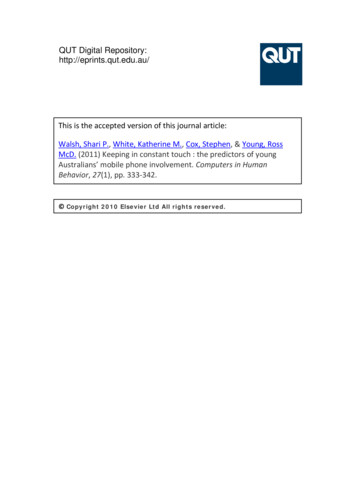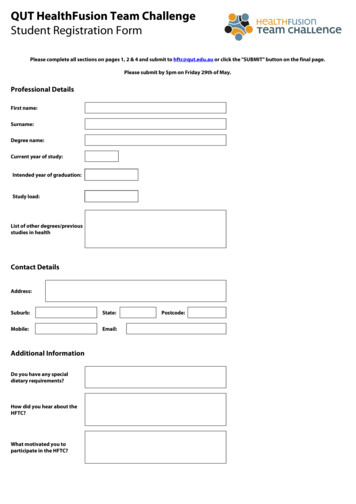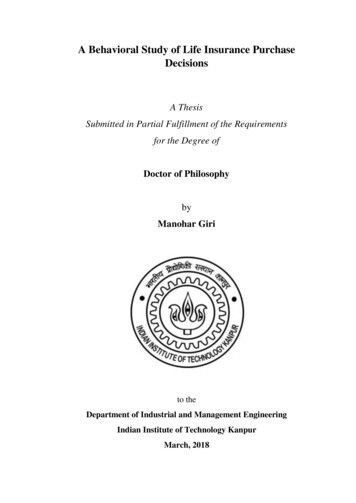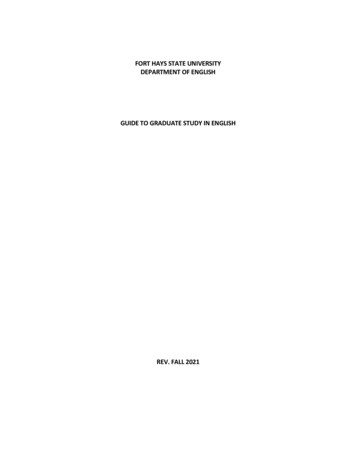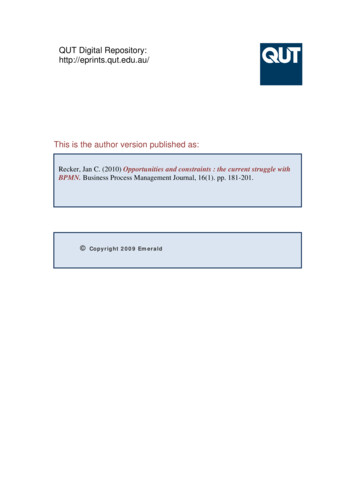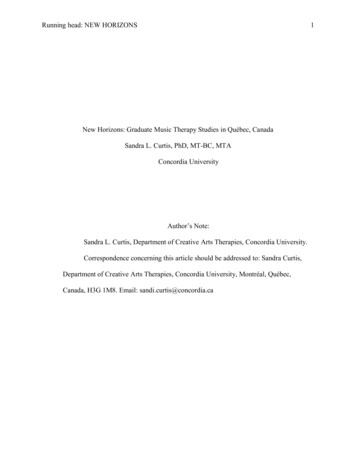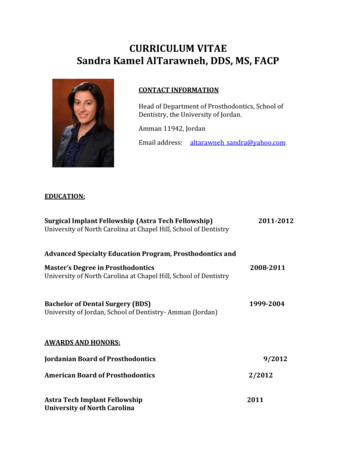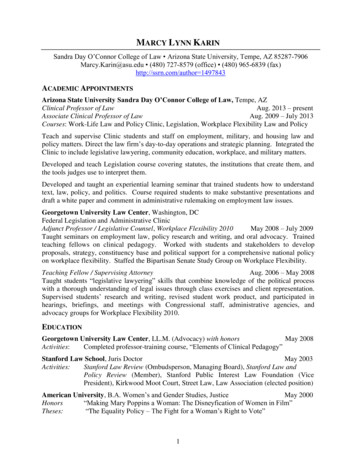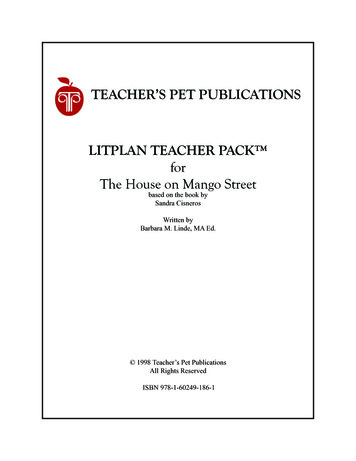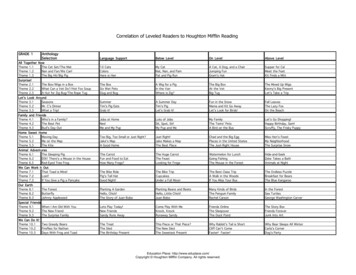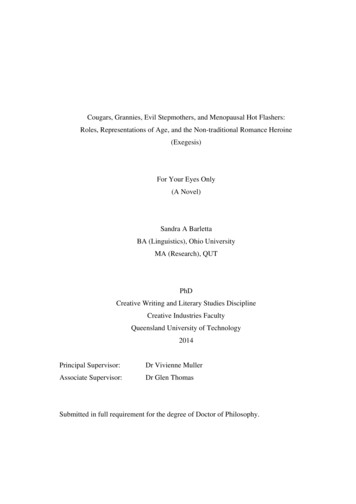
Transcription
Cougars, Grannies, Evil Stepmothers, and Menopausal Hot Flashers:Roles, Representations of Age, and the Non-traditional Romance Heroine(Exegesis)For Your Eyes Only(A Novel)Sandra A BarlettaBA (Linguistics), Ohio UniversityMA (Research), QUTPhDCreative Writing and Literary Studies DisciplineCreative Industries FacultyQueensland University of Technology2014Principal Supervisor:Dr Vivienne MullerAssociate Supervisor:Dr Glen ThomasSubmitted in full requirement for the degree of Doctor of Philosophy.
COUGARS, GRANNIES, EVIL STEPMOTHERSStatement of AuthorshipThe work contained in this thesis has not been previously submitted to meetrequirements for an award at this or any other higher education institution. To the bestof my knowledge and belief, the thesis contains no material previously published orwritten by another person except where due reference is made.Signature: QUT Verified SignatureDate: June 6, 2014i
iiCOUGARS, GRANNIES, EVIL STEPMOTHERSAbstractA love story is the fundamental component to a romance novel; it is what drives thegenre and what romance writers and readers expect to engage with in some form.However, after the age of 40, a woman is usually denied a place in the central love storyby the romance publishing industry via specific mandated guidelines for writers and aflow-on effect for readers. This study and companion novel For Your Eyes Onlyexplore the representations of older women as protagonists (the ‘heroine’) incontemporary romance fiction. The work argues that romance fiction maintainsstereotypes and archetypes of middle-aged and older women, which limits their rolesand behaviour to those of secondary characters, or removes them from the status ofcentral character in romance and places them in Women’s Fiction. This transfer from anovel where the love story is the key element of the plot to novels where a love story isonly a sliver of the plot, suggests that older women are not entitled to be the loveinterest in romance fiction. The exegesis and the novel consider and therefore challengethe constraints that are placed on romance writers who are guided by prescriptiveexpectations from publishers around the age of romance heroines.The study indicates that there is increasing evidence of an older age readingdemographic for romance texts, which demands romances featuring older women, andthere are romance authors who seek to shift the parameters of the central love story sothat it is more inclusive of older women. In some respects, this demand reveals that thegenre, while still retaining its fantasy and escapist inflections, is being called on to bemore ‘truthful’ in its inclusion and portrayal of women across all age demographics.The exegesis analyses the romance genre, the romance publishing industry,readers of romance and the few contemporary romance novels that feature a matureaged romance heroine. The creative work, For Your Eyes Only, constructs a narrative inwhich older women as romantic heroines can assert agency. The novel features aheroine who is not answerable to the demands of conventional romantic stereotypes andchallenges the conventions of age and the portrayal of non-traditional romance heroinesin contemporary romance novels. In other words, rather than become a stereotypedsecondary character that is often the case in romance novels, the mid-life romanceheroine of For Your Eyes Only, with her mature sexuality, life experience, and positionin society, is central to the love story and challenges the established and expected rolesfor a woman over 40 that are typically found in romance fiction.
COUGARS, GRANNIES, EVIL STEPMOTHERSiiiAcknowledgementsI am beholden to my Dad and tiny little mom for their love, enduring support, and givingme a sturdy sense of humour. I am so thankful to Lisa and Sean Barry, Elle Gardner,Kriss Wagner Plumer, Vassiliki Veros, and Kate Cuthbert for offering me constantencouragement and, most invaluably, coffee and cookies when I most needed them. Iam indebted to the romance writing and reading community, particularly via socialmedia. I am further indebted to Amy Andrews for her candour, Anna Campbell for heradvice and guruship, Stephanie Campisi for being interested, Jennifer Crusie for tellingme to ‘write the book I wanted to read,’ Rachel Bailey for being on the same page,Moriah Jovan for knowing badass women don’t have to be 23, Ainslie Paton for herfrankness, Dr Eric M Selinger and Dr Laura Vivanco, Dr Pam Regis, Dr An Goris, DrJayashree Kamble, Dr Sarah Frantz, Laurie Kahn and so many others for showingromance as significant and viable of scholarship, and finally, Sarah Wendell because in2007 her smartbitchestrashybooks.com website had a post on Hot Older Women, whichfuelled the fire already in my belly. As well, I thank The Romance Writers of Australia,the Romance Writers of America, Smart Bitches Trashy Books, Dear Author, ThePopular Romance Project, The International Association of the Study of PopularRomance, All About Romance, Teach Me Tonight, Read React Review, and Read In ASingle Sitting. I am very grateful for the guidance from my supervisors Dr VivienneMuller and Dr Glen Thomas, but mostly I am grateful to Mum and Dad for having DrJohn Barletta. This study and every novel I write would not be possible without hisunflagging support and unconditional love.
ivCOUGARS, GRANNIES, EVIL STEPMOTHERSTable of ContentsAcronyms and DefinitionsviIntroduction1Chapter 1. Literature Review111.1. Introduction111.2. Background: Romance scholarship111.3. Recent scholarship171.4 Femininity and age201.5. Women, age portrayals and the media24Chapter 2. Stereotypes, Older Women and Their Representation292.1. Stereotypes and the romance heroine292.2. Constructing femininity302.3. No home for old folks in romance332.4. Cougars, grannies, evil mamas: Mature women in romance35Chapter 3. Older Women, Romance Writing Guidelines and the Industry:393.1. Romance publishing: Industry facts and figures393.2. Guidelines for writing the romance heroine403.3. Catering to the mature market: Is it romance or Women’s Fiction?453.4. Limitations and attitudes from within the Industry50Chapter 4. Identification and What Older Readers Want554.1. Identification and the romance heroine554.2. Older readers of romance584.3. Giving consumers what they want61Chapter 5. But Does It Still Look, Feel, and Read Like Romance?645.1. Sex and the older woman: Jennifer Crusie’s older heroines655.2. Too old for love: Jeanne Ray’s Julie and Romeo695.3. The ravages of time: Nora Roberts’ Black Rose72Chapter 6. Creative Connection, Creative Practice756.1. Leading by my practice766.2. Ingredients in a recipe806.3. Coming of age and the ‘ten year rule’85Conclusion89References95
COUGARS, GRANNIES, EVIL STEPMOTHERSAppendix AAAR Booklist Mature Romancev106Appendix BAAR Booklist Plus-size Romance108Creative Work:For Your Eyes Only112
viCOUGARS, GRANNIES, EVIL STEPMOTHERSAcronyms and DefinitionsAARAll About Romance websiteHEAHappily ever AfterHFNHappily For NowHM&BHarlequin Mills and BoonHeroineThe female protagonist in romance fictionMature/Older HeroineAged from 40 to 60 for this studyRWARomance Writers of AmericaRWAusRomance Writers of AustraliaWomen’s FictionTerm the publishing and romance industry use as aclassificatory term for marketing purposesYAYoung Adult Fiction
COUGARS, GRANNIES, EVIL STEPMOTHERSviiKeywordsAgeing, ageism, fiction, publishing, contemporary romance fiction, love stories, olderwomen & fiction, older women & romance, romance fiction, romance novels, romancewriting, women & ageing, women & fiction, women & romance fiction.
COUGARS, GRANNIES, EVIL STEPMOTHERS1IntroductionThis thesis consists of a creative work, a romance novel, For Your Eyes Only, featuringan older female protagonist and a practice-led exegesis that investigates, from myposition as a romance writer, several aspects of the romance industry (publishing,romance writing guidelines, online romance reader sites) as well as the cultural field inwhich representations of women and age are situated. As a romance writer, Iacknowledge that the romance publishing industry is profit-driven and market driven.To take risks, as I do in writing about romance and the older woman, may attract areasonable following, yet is not standard fare for the majority of romance readers orwriters. It is a topic then that is largely ‘not for profit’. This being said, I am interestedin pursuing my interest in featuring older women as the centre of the romance narrative,a creative endeavour to, as Bly notes in New Approaches to Popular Romance Fiction,“reformulate the formula” (p. 69). There are a number of premises to this project. Oneis that older women in both society and in symbolic representation are oftendelegitimised as human beings worthy of consideration. There are of course exceptions,particularly in high-end literary work, as for example the female protagonists ofVirginia Woolf’s novels. In the popular literature context however, this relegation ofolder women to the social and cultural margins is often more pronounced as theromance genre has historically featured young women in the central role, sustaining thefantasy that love is only for the young. The second premise for the thesis is linked to thefirst. Popular culture has the capacity to inform ideas about social and cultural normsand therefore can be highly influential in the transference of knowledge and attitudes.Tilsen and Nylund (2009) write that “popular and media culture has gained hegemonicstatus, becoming perhaps the most powerful cultural force shaping cultural identitytoday” (p. 4). In this respect, the romance genre, as one form of popular culture with awide readership, helps to sculpt social ideas around love, romance, gender and genderedrelationships, gender expectations, and sexualised female and male bodies. The thesistherefore argues, as have other critical engagements with the romance genre, that itssustained focus on the heteronormative youthful female subject of romance constitutesa something of a symbolic annihilation of other forms of female identity.The third premise to this project is that the romance genre is not a fixed one.While it is a very durable genre, it has also been over many decades, a flexible one,constantly attuning to new readerships, being challenged by authors and scholars, and
2COUGARS, GRANNIES, EVIL STEPMOTHERSresponding to changing social patterns and values. While the love story between theprotagonists, obstacles to their relationship and the ‘happily ever after’ (HEA) remainstable/staple and defining tropes, there are many types of romances (Historical,Medieval, Regency) and many other contemporary romances generating their ownaudiences, their own market niches. These include GLBT romance, urban fantasyromance, erotic romance, New Adult, and paranormal romance. The genre, its formsand its conventions have been subject to feminist critical analyses for many years withmany approaches substantiating the links between fictional representations of womenand cultural realities. For example the most notable and the earliest line of criticismreproaches the genre for reinforcing women’s oppression within a patriarchal paradigm(Greer, 1970; Snitow, 1979; Radway 1984; Mussell, 1984). However, as the genre hasevolved in concert with the changing and diverse roles of women, especially withrespect to the construction of the romance ‘heroine’, critical analysis has alsodiversified its approaches. Issues of female empowerment, reader response, authorsovereignty, and changes and trends in the publishing industry are of interest to thewide field of romance genre scholarship. This thesis contributes to these conversationsfrom a writer’s perspective.The thesis is driven by a practice-led approach, which privileges the writing of acontemporary romance novel, For Your Eyes Only featuring an older woman as themain protagonist, and the experiences and understandings of what is involved in thatprocess as well as in the attempts to publish. A practice led study is idiosyncratic. AsDescartes (Meditation II) would submit, my experience is the only thing about which Imay be absolutely certain; what I discuss in my exegesis is an inference from my ownexperience as an author. My journey as an author who seeks to publish contemporaryromance novels that feature a non-traditional heroine, one who sits outside the norm forage, tests the elasticity of genre conventions, and tests conventions of an industryinterested in generating profit. The novel and the exegesis contribute to the argumentthat while the popular romance genre has undergone many shifts in its representationsof the heroine the dominant construction of the female protagonist is as a young womanin her twenties. The implication of this is that love and romance are for the young only.This notion is a stumbling block to writers of the genre (such as myself) who wish towrite about older heroines (40-60 years of age) in contemporary romance fiction.Fundamentally, the exegesis and the novel explore what happens to the contemporaryromance genre if there is an older heroine. What features of the genre, if any, are
COUGARS, GRANNIES, EVIL STEPMOTHERS3altered? Is the love story still central? Do the obstacles faced by the older heroine in herquest for love still fit with the crucial, defining feature of the romance genre? Is there anaudience for romance novels with mature-aged romance heroines? Is the true fictionalplace for women of a certain age Women’s Fiction (as defined by the publishers) ratherthan in the romance genre? The two components of this thesis, the novel For Your EyesOnly and the accompanying exegesis, have arisen out of these questions and are myattempts to counterbalance this age bias. As well, I set to explore some of the reasonsfor the bias through an investigation of the demands of the romance publishingindustry, prevailing cultural views of older women and a prevalent idea within theromance industry that considers Women’s Fiction as the ‘proper’ home for women of aolder age. These are the difficulties faced by an author who wishes to bend genreconventions and cultural norms.The questions guiding my research and my creative writing piece challenge whyso few older women are featured on a regular basis as romantic heroines in mainstreamcontemporary popular romance. My claim is that there is a growing readership for thecontemporary romance that centres on love and romance for an older woman. Theresearch is not only driven by my own practice, and the knowledge of other establishedpractitioners in the field who have tested the same question, but also by novice writersand avid, older romance readers in the romance reading community whose commentssuggest that they would like to see themselves represented in the fiction that theyclearly enjoy reading. While there are studies addressing the older female as the centralprotagonist in popular and literary fiction, such as Byrski’s (2010) Visible Signs ofAgeing: Representing Older Women In Australian Popular Fiction and Brennan’s(2005) The Older Women in Recent Fiction, there is little research on the role of matureaged women in romance fiction, either as supporting players or as the romantic lead.Nor is there much written regarding the implications for the romance genre should theinclusion of mature heroines occur. Further to this is the view held by publishers of theromance fiction that suggests mature-aged female protagonists fit better into Women’sFiction rather than in the romance genre.Women’s Fiction is a complicated label. James (2012) states “Readers, not tomention academics and publishers, wrangle endlessly about the definition of ‘women’sfiction’” ng-to-breathe-by-karenwhite/). For some, Women’s Fiction is a gendered grouping that separates any writingdone by women from the work of male writers, which often leads to discussions
4COUGARS, GRANNIES, EVIL STEPMOTHERSregarding the value of the writing, as well as the agency and oppression of women. YetWomen’s Fiction is also a market-driven word in the publishing and romance industry;that is publishers of romance use it as a classificatory term for the purposes ofdetermining where fiction written mostly by and for women might fit into a marketingcategory, who the potential readers might be, and how the stories will be marketed tothat audience. This process is what Thomas (2012) suggests is a ‘top-down’ model thatdecides a reader’s choice, rather than what a reader might actually want. Thomas’submission emphasises that the romance publishing industry is static, as it is motivatedby profit, by what sells best, by what sort of romance novel makes the most money. Inother words, romance publishing is ‘all about the money.’ In the case of the publishers’marketing classification, and purpose of this study, Women’s Fiction is used to referlargely to the Bildungsroman, or any story where the plot is focused on charting thefemale protagonist’s voyage of self-discovery or emotional and physical evolution. Thistype of narrative might, for example, be a multigenerational saga featuring principallywomen; or a ‘relationship novel,’ that is, the female protagonist’s relationship withfamily, friends or significant others. The delineation of the different types of writingfor, by and about women, established as a form of classification shorthand bypublishers, is what sets romance apart as a genre of its own. Simply put, for publishers,and many readers of the genre, romance fiction is driven by a love story with a happyending, or a possible future happy ending. Women’s Fiction may contain these elementsaccording to the publishers, but these do not drive the story, character development,relationships or conclusion, and a happy ending is not necessary.There are elements of the romance genre that confirm the centrality of theromance fantasy, distinctive fundamentals often referred to as the ‘formula:’ the lovestory, the obstacles the lead female character must overcome in pursuit of that love, andthe HEA, or as the Romance Writers of America (RWA) define it, “an emotionallysatisfying, optimistic ending” (http://www.rwa.org/p/cm/ld/fid 578). These elementsare an engaging part of reading romance, and what Fowler (1991) refers to as“anticipatory delights of this fiction” (p. 99). Implicated in the durability and success ofthe romance are the readers of romance. Most often, as indicated through readerresearch over many years, it is female readers of mainstream romance fiction who mostenjoy the genre and its conventions, who find pleasure in the text, and afford it a placein their lives for a variety of reasons. For the romance writer there is an obligation toarouse and satisfy the reader’s desire for love and romance, based on the view that the
COUGARS, GRANNIES, EVIL STEPMOTHERS5reader wants to read about these aspects, even if the fictionalised form of them isexaggerated and often more fantasied than ‘real.’ Escapism is a stable promise of genrefiction (Radway, 1984), but particularly within contemporary romance fiction there hasbeen, and continues to be, strong evidence from readers, authors and publishers thatsuch escapism is tempered by recognisable connection with ‘real life’ issues andexperiences without damaging the centrality of the love story. Crusie (1997) advocatesthat women read romance for many reasons, but one of them is to identify withsituations and characters that, despite their fantasised nature, also validate their lives insome way. Aspiring romance writers are advised by publishers and romance writingcommunities to ensure the heroine is one with whom readers can identify. So whileromance, as with other forms of genre fiction, has established conventions, over thedecades it has also exercised flexible parameters, attested to by the many changes thatthe genre has been subject to through various influences from other genres, in responseto societal changes around gendered identity and personal relationships and to readerdemand.The malleability of romance as a genre of fiction that accommodates andreflects changing social patterns—and tastes—is well documented historically and inpresent times, as Thurston (1985), Crusie (1997), and Wendell and Tan (2009) pointout. This is not to say that the genre adaptation around the representation of women hasticked all the boxes in terms of identity variants around ethnicity, sexuality, race andclass or any number of other aspects including age, which govern social and politicallife. Historically, as Dudovitz (1990) indicates, the romance genre once reflected orspoke for white, heterosexual, middle class women, yet today Harlequin’s Kimani Pressand Kensington’s Dafina lines have shifted the colour lines and offer representations ofmulticultural romance. Cawelti (1969) explains that there is a difference betweenconventions and innovations: conventions are the much-loved plotlines and stereotypedcharacters known to the creator of the work and the audience, while innovations areways of making conventions seem fresh. For example, author Suzanne Brockmanntakes a familiar romance character, the strong, silent, alpha male Navy SEAL hero, andgives him an unexpected unique quirk; the ability to belt out Broadway show tunes.With new twists on legends and fairy tales, adhering to successful codes and plotelements, surprising characters and occasional innovations, authors have foundinventive ways of incorporating political and social issues into their work, while stillrespecting the integrity of romance as a genre with its set of core conventions around
6COUGARS, GRANNIES, EVIL STEPMOTHERStrue love and how to get it. For example, Lesbian, Gay, Bisexual and Transgendered(LGBT) romance writing has been generated by authors and readers intent on givingvoice to a particular shared community around sexual identity and representation.While such variation on romance fiction is clearly welcome in many quarters by authorswho wish to work in a less constrained way with the genre and readers who make theirown informed demands on it, there is a less satisfying outcome for writers in mysituation who wish to feature older female heroine.Why should the older reader suffer from a loss of identification when, in fact,identification is touted as a crucial facet to keep in mind when creating a romanceheroine? What does this say about the ways in which older women in our society areviewed and represented? The dilemma of representation is complicated by the socialattitudes towards ageing in general and specifically towards older women. Therrien(2012) proposes that the romance narrative is a site where competing ideologies comeinto conflict, where something like gay, straightness, or, as I argue, a woman’s age canonly be negotiated out ‘safely;’ that is, in ways that “will not be contested, shifted, orconceded” (p. 165) from cultural norms or power relations. In The Older Women inRecent Fiction, Zoe Brennan (2005) identifies the lack of representation of the matureaged woman in fiction; and she also challenges the ‘safe’ ways women of age havebeen allowed to appear in popular fiction, such as Agatha Christie’s female sleuth MissMarple. Brennan’s observations on women and age are also pertinent to all forms ofpopular cultural representations of female senescence with regard to relationships,sexuality, and body images.Most female protagonists of romance fiction are young women between the agesof twenty and twenty-five, although in recent years the range occasionally pushes intothirty-something. The age of female readers varies enormously, but figures released bythe RWA (2011) shows females between the ages 45 and 54 make up the bulk ofromance readers, yet industry guidelines for romance writers either ‘suggest’ ormandate adherence to the younger age range, or as Avon Books’ Senior Editor LuciaMacro romance “heroines skew younger” (2012). The market is adept at classifyingwriting and creating reading communities around their products. Writing mature-agedheroines is seen to represent a “sales risk” as Escape Managing Editor Kate Cuthbert(2012) argues. Thus for the writer who wishes to write about an older female romanticlead, and for older female readers who do not necessarily want to read about the trialsand tribulations of a much younger character, the constraints (overt or covert) around
COUGARS, GRANNIES, EVIL STEPMOTHERS7representation and publication of the older female heroine are of social interest andrepresentational concern. In this practice-led study, I argue that romance fiction isshaped by and in turn shapes forces of culture, opinions, social behaviours, andcreative practices. The relationship between creativity and social and cultural values isa complex, contiguous and cyclical one. Creative writing itself is as malleable aspractice-led research. Haseman and Mafe (2009) propose that the formation of aresearch question does not happen in a clear-cut or immediate manner as it does in moretraditional forms of research. Exegetical methodology undertakes “a pluralist approachand use of a multi-method technique.[which is] tailored to the individual project”(Gray, 1996, p. 15). This study, set in a contemporary context, incorporates theory intopractice and discusses how my work intervenes in the stable tropes of romance fictionto produce certain desired outcomes. The practice-led research question is thereforeaddressed through the writing of a novel featuring an older female protagonist andthrough an exegetical discussion of the ways in which, as a writer of romance genre, Imanaged this disruptive shift of the genre’s stability and its outcomes. The exegesisexamines my creative work, For Your Eyes Only, in conjunction with that of otherromance writers to demonstrate I faced challenges shaped by the practitioners ofromance writing, by romance as a specific genre, by the romance publishing industryand how these related to my creative writing and creative writing practice. As well, theexegesis charts the creative context and evolutionary process of writing the novelwithin the constructs of popular society around women and age and the conventionsthat exist in the romance genre.The outcome of this thesis presents a knowledge base that is connected to whatRyan (2005) suggests is a wide pool of common human experience. In this case thecommon human experience is that shared by ‘women of a certain age’ who are readersof romance fiction and find themselves under-represented as heroines in the romancegenre and the small community of writers of romance who want to feature olderheroines but also pay heed to the conventions that are central to the romance genre.Chapter outlineChapter 1, the Literature Review, provides an analysis of the scholarship on romancefrom the 1970s to the present and the ways in which it has been positioned withincultural, critical and publication discourse. Drawing on feminist theories of the femalebody and the social construction of ‘femininity’, this chapter also establishes that
8COUGARS, GRANNIES, EVIL STEPMOTHERSnegative and minimal representations of older women are part of the larger society’sabjection of age and female sexuality.Chapter 2 discusses the topological features of romance fiction and examinesthe ways in which representations of the older women are relegated to secondary roleswithin romance fiction. It also explores the romance heroine and her transformationfrom submissive secretary to boss, and how the heroine’s role has changed in the last 30years. I define stereotypes, archetypes, and traits associated with women and agethrough an analysis of contemporary romance texts that emphasise roles and ageexpectations for women over 40 women, and texts, including my own, that disrupt theseexpectations. I argue that this has implications for the representational value olderwomen have in media, and the ways in which they are represented in romance fiction.Chapter 3 discusses the guidelines for writers of romance and the prescriptiveexclusion of older women as romance heroines. It also recognises the limited researchregarding older women and romance, the importance of reader identification as a keyplank in the writing, publishing and marketing of romance, the ramification of theseaspects for writers and readers with specific reference to my own creative practice. Inan attempt to understand the perceived ‘safety area’ for mature-aged women inWomen’s Fiction, that is where publishing house marketing departments regard as asafer bet for profits and the notion that non-romantic characterisations are the sort olderwoman should aspire to, this chapter also examines the normative expectations of thepublishing industry and the embedded attitudes regarding older women as romanticleads. I make note of how this attitude can be perceived as a risk aversion, yet alsodocument of the rise of digital romance publishing and this may be the forefront ofinnovation.Chapter 4 makes note that there is a demand for greater age representation inromance and offer evidence from social media and reader websites. Authors and readersare becoming increasingly vocal using many forums including annual romance writers’conventions and websites to state their opinions on the need for inclusion of olderheroines.Dovetailing into the desire readers have for inclusion of better representation,Chapter 5 inspects three authors and their contemporary romance novels that featuremature-aged heroines: Jennifer Crusie’s Fast Women, Jeanne Ray’s Julie and Romeo,and Nora Roberts’ Black Rose. I ascertain if any features of the genre are altered if theheroine is older, I establish that the love story is still central, and make note that the
COUGARS, GRANNIES, EVIL STEPMOTHERS9obstacles faced by the older heroine still fit with the crucial, defining feature of theromance genre. This chapter explores how these authors challenge
2.3. No home for old folks in romance 33 2.4. Cougars, grannies, evil mamas: Mature women in romance 35 Chapter 3. Older Women, Romance Writing Guidelines and the Industry: 39 3.1. Romance publishing: Industry facts and figures 39 3.2. Guidelines for writing the romance heroine 40 3.3.
